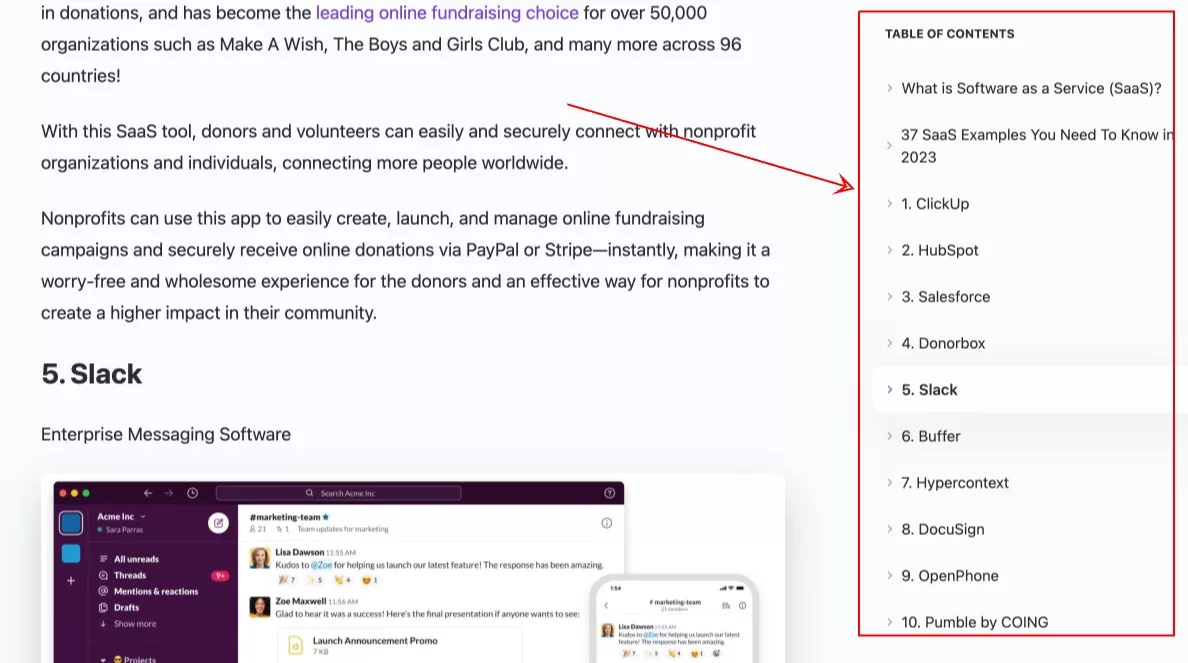by Venchito Tampon Jr | Last Updated on July 3, 2023
If you think link insertion is everything but placing links on an existing article, there are more parts than you have ever thought of.
SEOs have been accustomed to writing new guest posts to get fresh site backlinks for years. But with the increasing costs for content and daily “guest post” pitch every online publisher receives, link insertion has become the go-to link building solution for many SEO agencies and online marketers.
What is a link insertion?
Link insertion is an effective link building strategy that involves placing a link within relevant content on an established website. This is typically done through direct outreach to the appropriate resource to enhance the reader’s experience and improve search engine optimization.
By incorporating links seamlessly into existing content, link insertion aids in building credible connections and enhancing website visibility.
Link Insertions vs Guest Posting, what’s the difference?
While acquiring links from link insertion and guest posting can pass link equity to their destination pages, there are major considerations to see which link building strategy would suit you best.
At most, you want to diversify link types when doing link building campaigns. It looks natural from Google’s eyes and serves as your safety net whenever a link type suddenly diminishes its value.
Link insertion focuses on getting backlinks from existing pages (e.g., blog posts) of a website, while guest posting leads to publishing new articles.
Link insertion is easier because you only need to find a relevant page/blog content where you can place the link. In contrast, guest posting requires new blog content to publish as the source of a link.
How to Do Link Insertion?
Link insertion requires the same typical link building process, from link prospecting to outreach, but demands a different in its earlier stages. Here’s how to do it.
Step 1: Find Website Backlink Opportunities
Manual Search
You can use manual Google search, utilizing the appropriate Google search operators to find your target blogs or online publication.
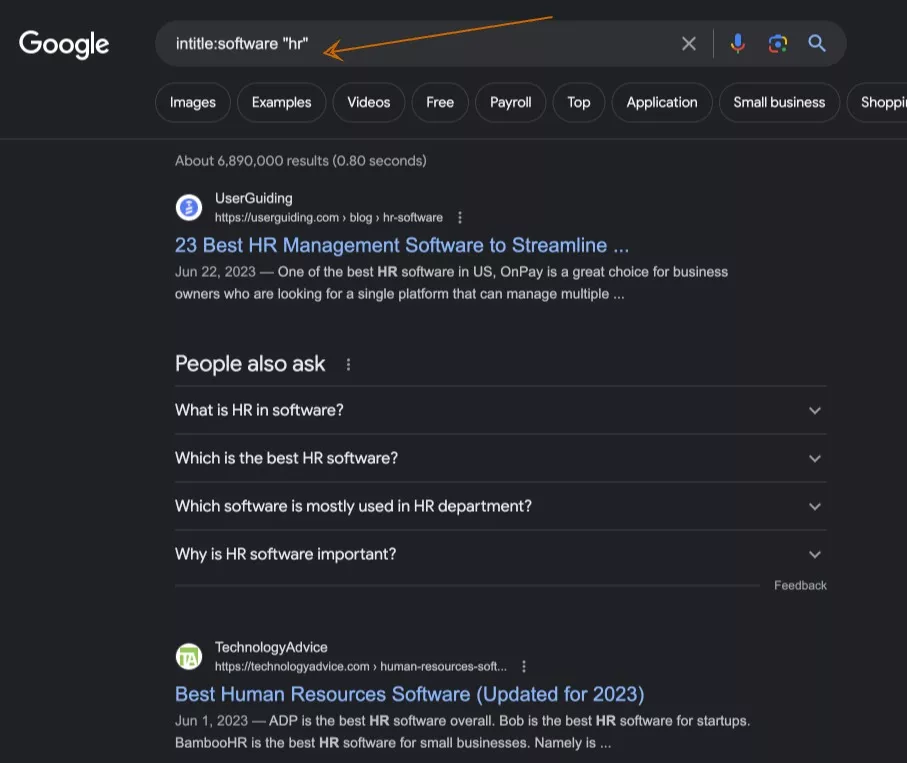
Here is a quick cheatsheet for Google search queries for link insertion:
- inurl:links.html “topic” (e.g. inurl:links.html “small business”)
- inurl:.com “topic” (e.g. inurl:.com small business)
- inurl:/blog/ “topic” (e.g. inurl:/blog/ business expense tracker)
- inurl:/topic/ “keyword” (e.g. inurl:/business/ “things you need about startup” )
Competitors’ Links via Finding on Ahrefs
Another way is to use Ahrefs to find competitors’ backlinks and acquire those same links through link insertion.
Here’s how to find competitors” backlinks that are the potential for link insertion:
- Go to Ahrefs’ Site Explorer.
- Enter the domain of your competitor.
- Go to the Backlinks report.
- Filter for do follow links.
- Filter for links with in-content backlink type.
- Filter for links with a minimum DR20+ (our minimum DR benchmark).
- Filter for links with relevant keywords (use “Filter” Keyword)
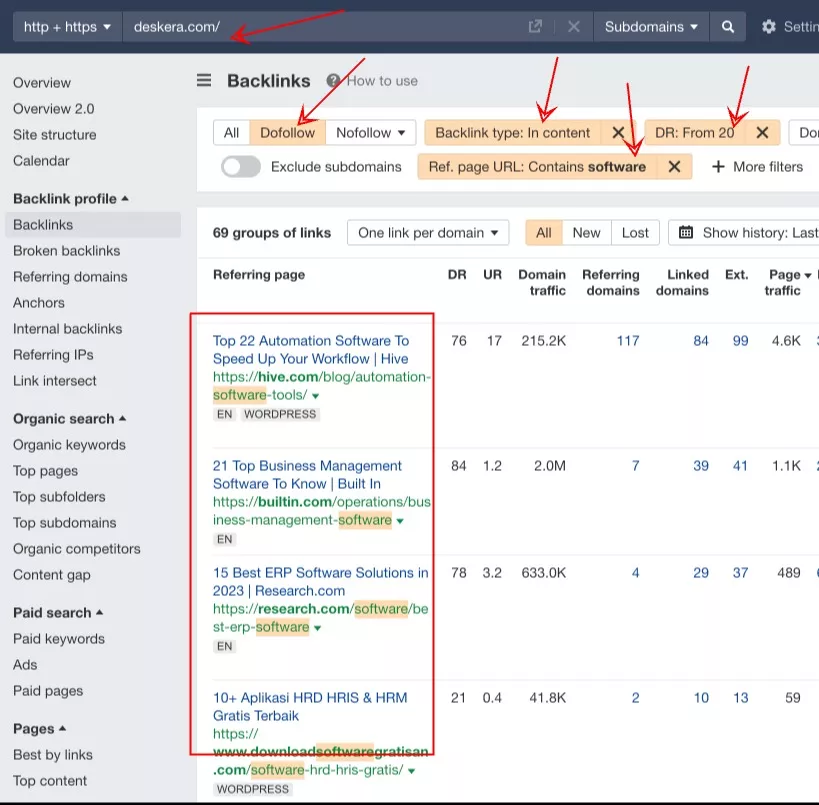
See which blog posts are relevant and reach out for link inclusion.
Pro tip: You can use “content update” as an additional value proposition in your outreach. So, instead of simply asking for a link from their blog post, you could show how updating the page might benefit them to increase their site’s organic traffic.
Another pro tip: Find a more relevant blog post on the same website. If you’re trying to rank for a specific page, getting a more relevant linking page is best to maximize the link’s value.
Do a Google search for site:domain[dot]com.
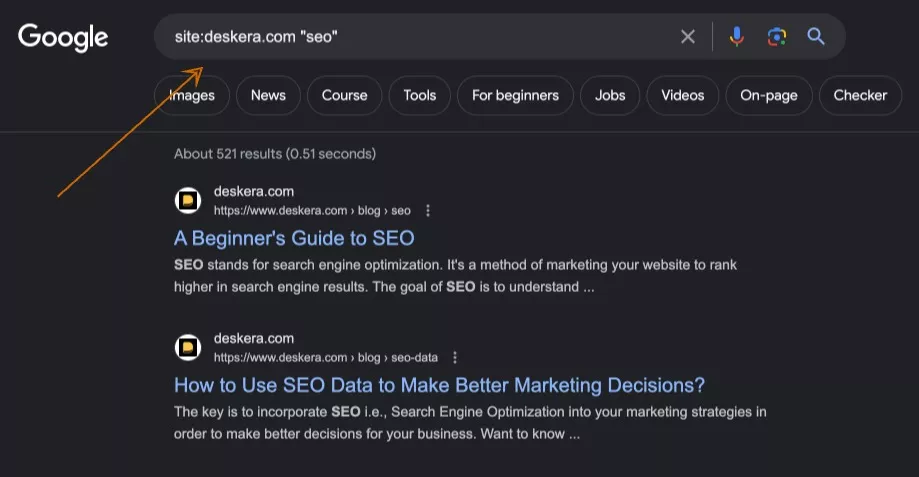
Content Scouring
Take link inclusion prospecting to the next level by finding industry blogs you haven’t reached acquired links yet.
You can use Ahrefs’ Content Explorer to find new and existing promising blogs. With creative search queries, you can filter your search websites that are topically relevant to your target page.
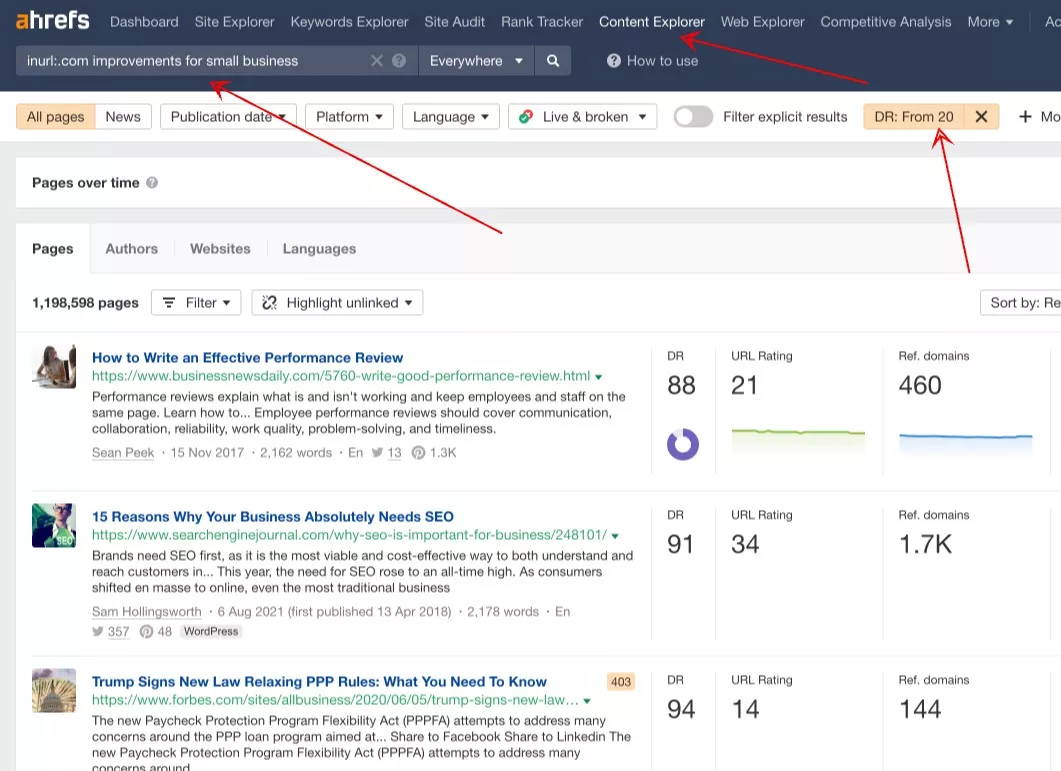
By doing this process, you’ll get domains. And to find existing articles for link inclusion, you can use the site search operator on Google to find the most relevant existing article.
Step 2: Qualify Potential Link Targets
Link qualification is vetting websites based on link metrics to ensure who links to your site have authority and trust.
These link metrics are necessary for link insertion to maximize value from every link placement.
Relevance
Your target linking page must be topically relevant to your destination page. If you’re trying to get a link for the “espresso machines” page, it is best to get links directly from blog posts about espresso machines, espresso, or coffee.
Authority Metrics
Authority metrics are proprietary compound metrics invented by link intelligence tool creators such as Moz, Majestic, and Ahrefs. Ahrefs’ metrics, considered the top metric to measure a site’s overall authority, are based largely on the quality and quantity of links pointing to its pages.
You can use any of these compound metrics or combine both. Our link insertion service prefers Ahrefs’ Domain Rating (DR) and URL Rating (UR).
Ahrefs’ Domain Rating is a domain-level metric, from a scale of 1 to 100, that measures the domain ranking’s power, depending on the quality of links pointing to the website. The greater DR is, the more potent it passes to its destination pages.
We recommend getting only link inclusion from websites with DR25+. While this varies depending on industries, where highly particular industries would only have a few blogs to target – in this case, you can lower your DR25+. But to get the most value, the greater the DR+ site backlinks you get, the more benefits it is for your website.

Ahrefs’ URL Rating is a page-level metric. From 1 to 100, it measures the pages’ ranking ability to pass link juice to all its destination pages.
Most SEO specialists would only consider Ahrefs’ DR as their authority metric for link inclusion. But Ahrefs’ UR should also be a link metric to pay attention to if you’re landing links from an already-existing page.
Consider having an Ahrefs’ UR of 15 or 20+ when vetting existing blog posts for link inclusion.
Trust Metrics
Verifying a site’s trustworthiness is essential to avoid bad links to your website. While no unlimited options are available to measure how trustworthy a site is, there is a way to measure the trust quality of a website.
Majestic SEO, another link intelligence developer, has invented Trust Flow. It measures the site’s quality based on how closely related it is to Majestic’s handpicked seed sites. These seed sites are reputable, manually reviewed, and linked to other reputable sites, making it difficult for anyone to manipulate rankings for this metric.
We recommend getting website prospects with at least a Trust Flow (TF) of 15 or better.
Unique Referring Domains
While you can settle for authority and trust metrics, you could easily end up with websites with high Ahrefs’ DR/UR but only a few linking domains.
One best indicator of a good link opportunity for link insertion is when the site has many unique linking domains. This shows that the website gains popularity in terms of how many people are engaged in linking to a site.
It also serves as an authority signal, given more websites within the niche, from distinct IPs, have trusted the website through their linking.
Organic Traffic Trends
One of the biggest traps for link builders is getting a link from a website with high authority but considered to be toxic links. How possible is that?
While most link intelligence tools will show you a high rating for the website, it doesn’t give the full picture of how Google sees it based on its algorithms. Google can strike down a website due to penalty but still show a sign of high authority metric.
Check if there is a sharp decline in organic traffic or an increasingly upward trend, which signals it is a good link opportunity to pursue. SEMRush’s search domain tool can check the site’s estimated search performance in recent months.
A good link opportunity for link insertion has an on-the-rise search traffic like this one:
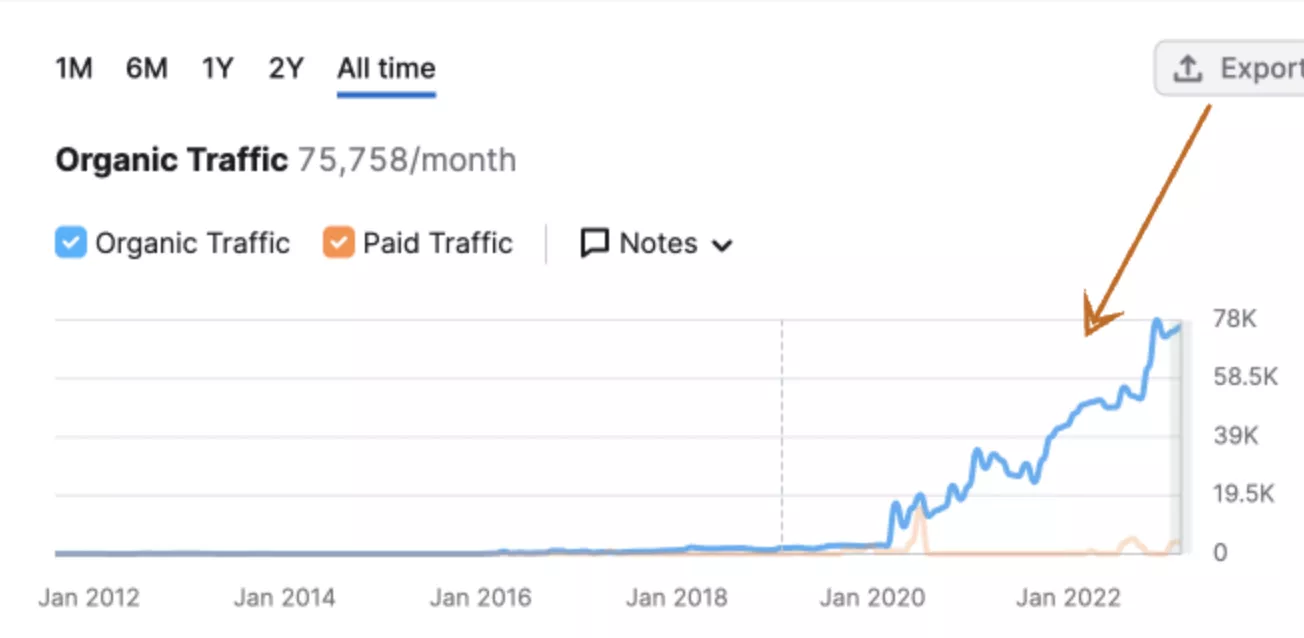
You should look at These core link metrics to ensure every backlink from link insertion counts.
Step 3: Pick Existing Pages For Link Inclusion
The beauty of link inclusion is you don’t have to write new articles as guest posts. But you simply have to choose the right target pages where you’ll land your backlinks.
Different types of link inclusion accounts for different destination pages.
For example, if you want to build more links to your product or service pages, you should get contextual backlinks from top X service list posts.
Top X Blog Post
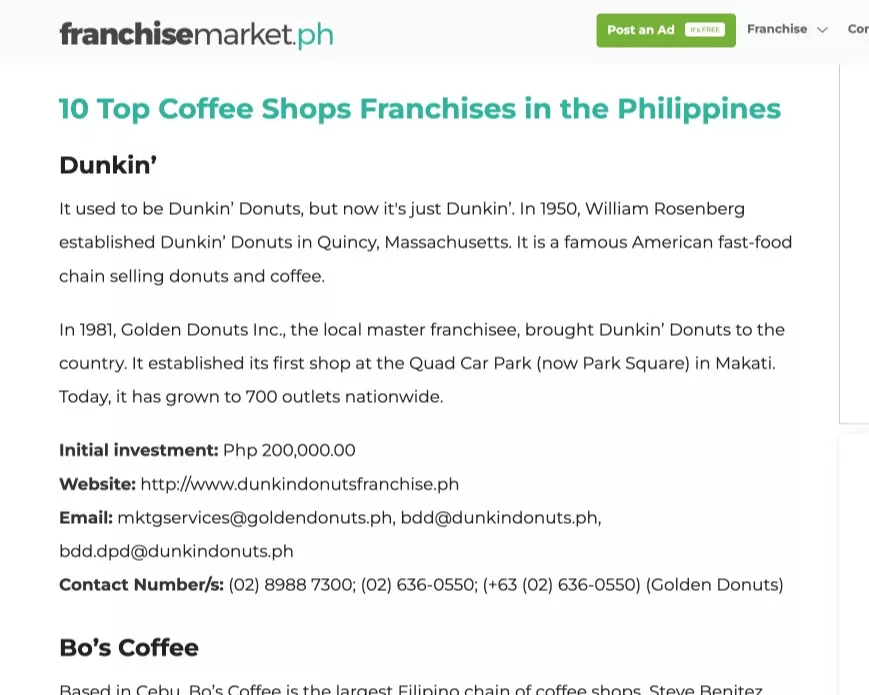
When you have the list of domains qualified based on our link metrics earlier, you can use the site search operator to find relevant top/best X listicle posts.
Pro tip: Find ranking list X blog post and reach out to include your products/services. These pages have higher link equity, as it receives organic traffic via ranking for “top X keywords”.
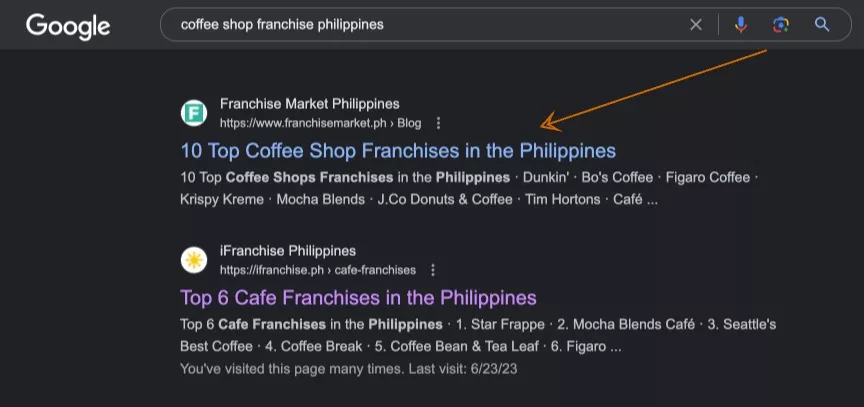
We’ve done a quick manual outreach for one of my businesses, a coffee shop franchise. And get included in rankings “top X product/service providers” pages.
On top of the link equity, the listicle page can pass to your landing page. You’ll also receive additional referral traffic and assisted conversions from new organic visitors, as its rankings for related long tail keywords (“top X product/service”).
Topical Blog Posts
Getting editorial links from blog content is the most usual type of link inclusion. Requesting a link from link placement is within the reach and efforts of the content writer, as they can simply edit the article and place your backlink on the most relevant section.
The ideal link inclusion strategy is to get links from the most relevant blog content, respective to your linking-to page.
In our recent example, if you add an inbound link for a collection page about espresso machines, you should get a link from an article about ‘espresso machines.’
Try to target the most relevant blog post. When you can’t find one, look for the next topical content – in our example, it would be to find articles about the brewing process or coffee.
Pro tip: Write a paragraph or a whole section of a subtopic within the article. This would help more contextual relevant for the backlink to fit within the topic of the content.

It is best to organize your website prospects: domains and their topically relevant pages for link inclusion. This way, you can easily monitor link placements.
Step 4: Do Link Insertion Outreach
One link prospecting and target page finding has been covered. It’s time to reach out to these folks and get the desired backlink.
Here are some actionable tips to make an effective link insertion outreach:
- Do outreach from the angle of a content marketer. Reach out to add more references/resources for their readers. Bloggers and online publishers are more willing if your pitch adds additional value for their readers.
- Use other techniques on top of link insertion requests, such as suggesting corrections to broken link errors, grammatical mistakes, or additional methods to grow their site’s traffic.
- Invest in growing relationships by seeking mutually beneficial partnerships (i.e., you’ll link back to one of their blog content, as long as it is contextually relevant to one of your articles).
Link Insertion Outreach Templates
For listicle outreach, it could be the brevity and simplicity of your outreach template that will help you land your backlinks.
Here is one sample of an email that perfectly works fine for listicle creators:
Subject: New Product/Service/Tool for Top X [Topic]
Hey [First Name],
I noticed that you have a list of businesses offering [describe the offer]
[insert URL to their top X page]
I just want to let you know that we are offering a [describe your offer and give discount details if you offer one].
Let me know if there’s any other information you would need from us.
Thanks, [First Name].
[Your Name]
If your landing page details fit their listicle, you can get the desired link without being aggressive.
Keys to Outreach Success:
- Personalization – know who writes and edits the article, so you can easily connect why your page will be valuable to their visitors.
- Include only the relevant details of your product, don’t try to suggest over. See how they wrote about each listed service/product provider and provide a similar content write-up.
For a typical link insertion outreach, you can use this email outreach template:
Subject: Content Partnership – [Website Name] x SharpRocket
Hi, [Website Name] team!
Just thought of reaching out to see if you’d be interested in exploring some cross-content promotion opportunities with SharpRocket?
We have several high-traffic content assets where we can promote relevant guides from your blog.
Let me know your thoughts.
Thanks and stay safe!
– [Your Name]
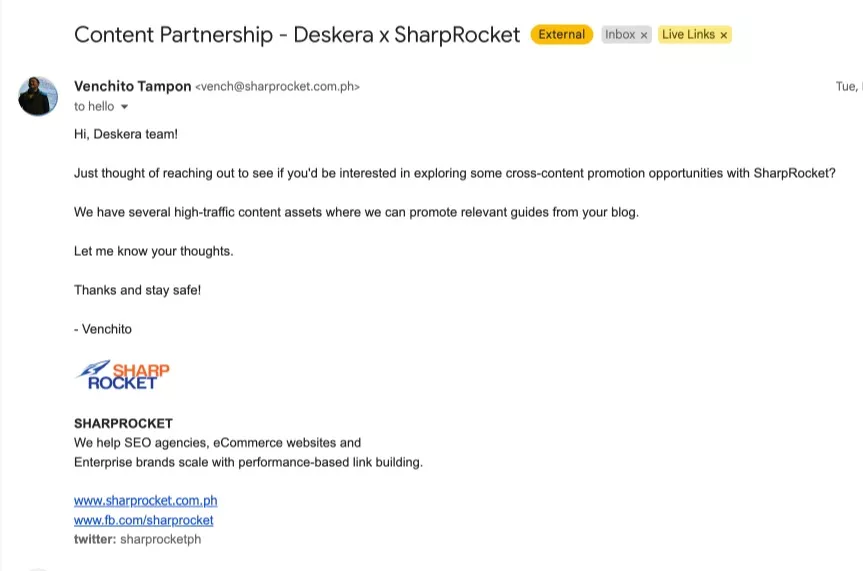
Keys to Outreach Success:
- Be straight to the point. Avoid starting your email pitch with “I’ve been an avid reader of…” when you’re not genuinely a fan reader of the blog.
- Offer to help. These webmasters may be looking for link exchange opportunities.
- Ensure the content you’ll suggest to be included on the blog content is highly relevant to its topic and target audience.
- Send shorter emails in your initial contact (this increases response rates), as you can send a more detailed email as soon as you get a response from your prospects, increasing your closing rates.
Advanced Link Inclusion Strategies
Following the link inclusion strategies, you can acquire an optimal number of links. But if you want to dig in more gold, here are some advanced link inclusion strategies to prospect better link opportunities and land more link placements.
Leverage your other sites for link exchange opportunities.
There is an increase in demand for a link exchange, given its simplicity and convenience of acquiring links without relying on new content.
And this probes for more content opportunities for anyone engaging in link inclusion outreach.
You can use other web properties (other sites you own) and use content partnerships as an angle when reaching out to potential linkers. You increase close rates in your linker outreach campaign by offering them a cross-promotion opportunity (link exchange).
If you’ve got a higher DR site, it’s more attractive to your potential linking targets than offering them a lower DR domain.
Initial linking before contact
You make prospects familiar with your work by engaging your prospects by linking to them from your content initiatives (through your own content or guest posts on sites).
Especially if you’re targeting high-end prospects, this should help increase getting a response from them. A reciprocal method for linking would work in your favor.
Shoot for more link inclusion opportunities through reverse engineering.
Once you see a “top X service/product” list article, you can check pages pointing to each product listed. Chances are other listicle pages are pointing to them. You can reach out as well for your link inclusion.
Use your non-content resources.
One best way to penetrate webmasters and content publishers is to offer your non-content resources, i.e., email list, affiliate programs, and premium access to products, as an angle to increase responses from your link prospects and close more link placements.
By offering non-content assets, you increase your link acquisition campaign’s efficiency and links output, making it a scalable link-building strategy.
Link Insertion Frequently Asked Questions
What is an example of link insertion?
An example of link insertion is when a blog mentions a topic briefly and provides a link for readers to access more detailed information. One instance is including a link for plumbing and drain cleaning in a home blog post to learn more about this topic. Optimizing blog content with relevant links enhances the reader’s experience and provides valuable resources.
What is a link insertion on an existing post?
A link insertion, also referred to as a niche edit, involves adding a link to already published content. It is a popular link-building strategy where you request a link to your website from existing content on another site. Link insertions can significantly enhance your SEO efforts by increasing your website’s visibility and authority.
How do I find link insertion opportunities?
To find link insertion opportunities, conduct keyword research to identify relevant topics. Next, reach out to websites through personalized emails, social media, or networking events, offering valuable content relevant to their audience. Lastly, track your outreach efforts and monitor the performance of the inserted links to evaluate their effectiveness.
The Author
Venchito Tampon Jr
Venchito Tampon is a Filipino Motivational Speaker, Corporate Trainer, and a Leadership Speaker in the Philippines. He is the CEO and Co-Founder of SharpRocket, a link building agency. With a decade of experience, Venchito has a proven track record of leading hundreds of successful SEO (link builidng) campaigns across competitive industries like finance, B2B, legal, and SaaS. His expert advice as a link building expert has been featured in renowned publications such as Semrush, Ahrefs, Huffington Post and Forbes. He is also an international SEO spoken and has delivered talks in SEO Zraz, Asia Pacific Affiliate Summit in Singapore, and Search Marketing Summit in Sydney, Australia. Check out his other businesses, Hills & Valleys Cafe, Blend N Sips and Saas Pursuit.
How our LINK BUILDING AGENCY builds 250 links/mo consistently using Predictable Link Building Methodology™…
- Using a SIMPLE and PROVEN system
- Using a SCALABLE strategy
- No private blog networks
- No creepy outreach emails
